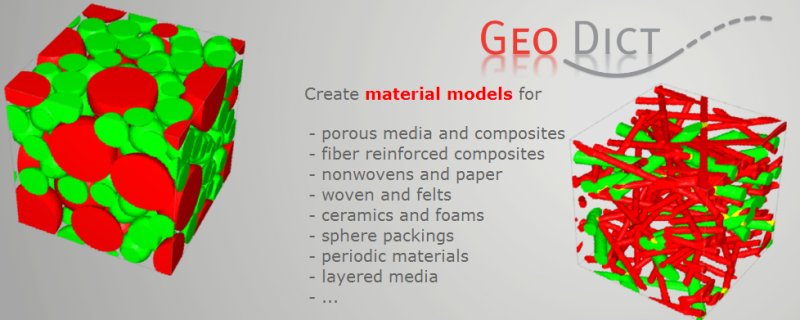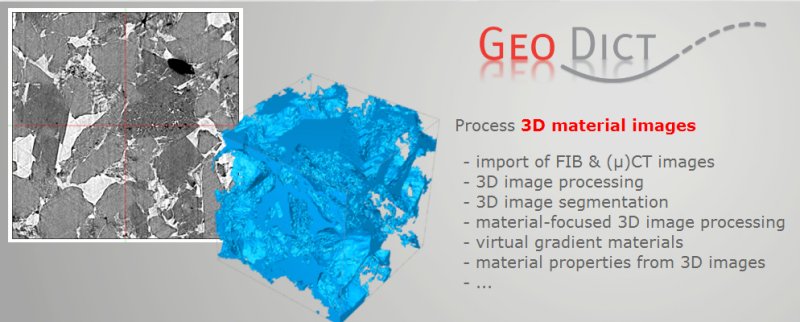 GeoDict
GeoDict

GeoDict® is the innovative, integrated, and easy-to-use material simulator made by Math2Market®.
GeoDict is the complete software solution for multi-scale 3D image processing, visualization, simulation-driven property characterization, material development, and process optimization.
- Fast simulation of experiments to determine material properties
- Repeated non-destructive prediction of material properties
- Reduction, or even elimination, of need for expensive and time-consuming laboratory tests
- Design of innovative materials to fit requirements for many industrial sectors
- Import and segment 3D-material images from CT-scans, μCT-scans, or FIB/SEM-scans
- Convert 3D-images into 3D material models
- Compute 3D geometrical and physical material properties by simulation
- Output and export data for input to CAE tools and other CFD software
- Design novel materials on the computer
- Visualize 3D material models and property simulation results
- Analyze and plot property simulation results
- Script command sequences to automate time-consuming, routine parameter studies

GeoDict®
imports, segments, and converts
X-ray CT-scans, μCT-scans, and FIB-SEM data into 3D models
| ImportGeo | filters and segments 3D image-data, such as CT-scans, μCT-scans, and/or FIB/SEM-scans, and builds 3D material models |
| ProcessGeo | processes and transforms 3D material models built from imported and segmented 3D-images (from CT-scans, μCT-scans, and/or FIB/SEM-scans) |
| LayerGeo | overlays and combines 3D material models built from imported and segmented 3D-images (from CT-scans, μCT-scans, and/or FIB/SEM-scans) to construct complex 3D models |
| EditGeo | manually edits 3D voxel material models built from imported and segmented 3D-images(from CT-scans, μCT-scans, and/or FIB/SEM-scans) or generated 3D voxel material models |
Convert 3D-images into 3D material models
| ImportGeo | filters and segments 3D image-data, such as CT-scans, μCT-scans, and/or FIB/SEM-scans, and builds 3D material models |
| ProcessGeo | processes and transforms 3D material models built from imported and segmented 3D-images (from CT-scans, μCT-scans, and/or FIB/SEM-scans) |
| LayerGeo | overlays and combines 3D material models built from imported and segmented 3D-images (from CT-scans, μCT-scans, and/or FIB/SEM-scans) to construct complex 3D models |
| EditGeo | manually edits 3D voxel material models built from imported and segmented 3D-images(from CT-scans, μCT-scans, and/or FIB/SEM-scans) or generated 3D voxel material models |
Compute 3D geometrical and physical material properties by simulation
| DiffuDict | calculates effective diffusivity and tortuosity factor. |
| ConductoDict | computes effective electrical and effective thermal conductivity. |
| FlowDict | simulates fluid flow (air, gas, water, oil, etc.), and calculates hydraulic properties such as pressure drop, viscous resistivity, and permeability. |
| ElastoDict | predicts effective elastic properties (Youngs modulus and full elasticity tensor), compression and deformation in 3D structures. |
| FilterDict | calculates pressure drop, filter efficiency, and filter life time. |
| SatuDict | assesses pressure-saturation curves, capillary pressure curves, and relative permeability, relative diffusivity, relative thermal conductivity, and relative electrical conductivity by the full morphology method. |
| PoroDict | calculates pore structure characteristics: pore size distribution, percolation paths, surface area, three-phase contact, open and close porosity, chord length distribution, bubble point, euclidean distance transform and pore identification. |
| AcoustoDict | computes media-dependent acoustic absorption parameters for acoustic models. |
| AddiDict | simulates particle transport in a liquid flow or a gas flow through porous materials |
Output and export data for input to CAE tools and other CFD software
| ImportGeo | ImportGeo-Base imports analytic geometry descriptions through the GADFile Format. ImportGeo-Vol imports CT-scans or other 3d image-data. ImportGeo-CAD imports and visualizes stl-files (Stereolithography). |
| ExportGeo | ExportGeo-Base exports GeoDict 3d-material models as voxelized or analytic data, to volume image data formats such as *.raw, *.vol, and *.png. ExportGeo-CAD exports GeoDict 3d-material models to CAD-formats such as *.stl(Stereolithography), *.wrl (Virtual Reality Modeling Language),*.x_t (Parasolid), *.igs(IGES), *.stp (STEP) and *.sat (ACIS). ExportGeo-Fluent exports computational set-ups for GeoDict material models or 3d-images to be executed in Fluent-Flow or Fluent-Heat for flow or thermal conductivity computations. ExportGeo-Abaqus exports computational set-ups for GeoDict material models or 3d-images to be executed in Abaqus for elasticity computations. |
| FiberGeo | generates virtual non-woven materials and fiber reinforced composites |
| GrainGeo | generates virtual sintered ceramic materials and virtual packings of spheres combined with other objects (ellipsoids, boxes, ...) |
| PaperGeo | generates virtual paper structures |
| WeaveGeo | generates woven media |
| PackGeo | generates (dense) sphere packings |
| PleatGeo | generates single pleats of filters |
| GridGeo | generates virtual regular-grid materials |
| FoamGeo | simulates closed-cell and open-cell foams and generates virtual sponges |
| LayerGeo | creates layered media from imported 3D material images (CT-, μCT-, or FIB/SEM-image data) or generated virtual media (wovens, nonwovens, grids, foils, foams, ceramics, composites...) |
| GadGeo | constructs material models and general three-dimensional objects |
| DiffuDict | calculates effective diffusivity and tortuosity factor. |
| ConductoDict | computes effective electrical and effective thermal conductivity. |
| FlowDict | simulates fluid flow (air, gas, water, oil, etc.), and calculates hydraulic properties such as pressure drop, viscous resistivity, and permeability. |
| ElastoDict | predicts effective elastic properties (Youngs modulus and full elasticity tensor), compression and deformation in 3D structures. |
| FilterDict | calculates pressure drop, filter efficiency, and filter life time. |
| SatuDict | assesses pressure-saturation curves, capillary pressure curves, and relative permeability, relative diffusivity, relative thermal conductivity, and relative electrical conductivity by the full morphology method. |
| PoroDict | calculates pore structure characteristics: pore size distribution, percolation paths, surface area, three-phase contact, open and close porosity, chord length distribution, bubble point, euclidean distance transform and pore identification. |
| AcoustoDict | computes media-dependent acoustic absorption parameters for acoustic models. |
| AddiDict | simulates particle transport in a liquid flow or a gas flow through porous materials |
GeoDexcel allows a deeper analysis of the numerical solver results and generating a variety of charts to graphically characterize structure properties. GeoDexcel automatically loads the result files data in the adequate form into the spreadsheet. The chart type selected by the user is created with GeoDexcel by automatically locating and loading the necessary data among the cells in the spreadsheet. To use GeoDexcel, Microsoft Excel™ (version 2007 or newer) must be installed on the computer.
To use GeoDexcel, Microsoft Excel™ (version 2007 or newer) must be installed on the computer.
For the Dict modules, GeoDexcel offers the following analysis and charting:
- FilterDict: filtration efficiency charts, particle deposition charts, and charts showing the pressure drop evolution during a filter lifetime simulation.
- FlowDict: combination of results from different flow experiments and then, for comparison, plot the average flow velocity in the selected flow direction for all of them.
- MatDict: plotting of the solid volume fraction (SVF), and components analysis.
- PoroDict: plotting of Through Pores, the cumulative geometric PSD and the density of geometric PSD.
- SatuDict: output of capillary pressure curves, the relative conductivity and relative diffusivity charts, and the permeability chart for the non-wetting and the wetting phases.
Macros offer the advantage of:
- automating sequences of operations
- without intermediate user interaction
- with automatic parameter variation
- without intermediate user interaction
- eliminating the error-prone and time-consuming sequential introduction of values, and clicking of buttons, for frequently repeated processes
- documenting and allowing editing of input parameters
- using Record to optionally postpone the execution of sequences of operations for complex parameter studies.
- modifying an isolated parameter in a recorded macro using any text editor
- executing the script without the graphical user interface (GUI), simply as a command line tool
The downloads in this area are secured with the username and password that were given at the closing of the meeting, but you can receive them by contacting us at:
user.meeting@geodict.com.
2015 Book of abstracts
Presentations of the GeoDict 2015 User Meeting (zip-file)
From the User Meeting 2014:
2014 Book of abstracts
Presentations of the GeoDict 2014 User Meeting (zip-file)
From the User Conference 2013:
2013 Book of abstracts
Presentations of the GeoDict 2013 User Conference (zip-file)



